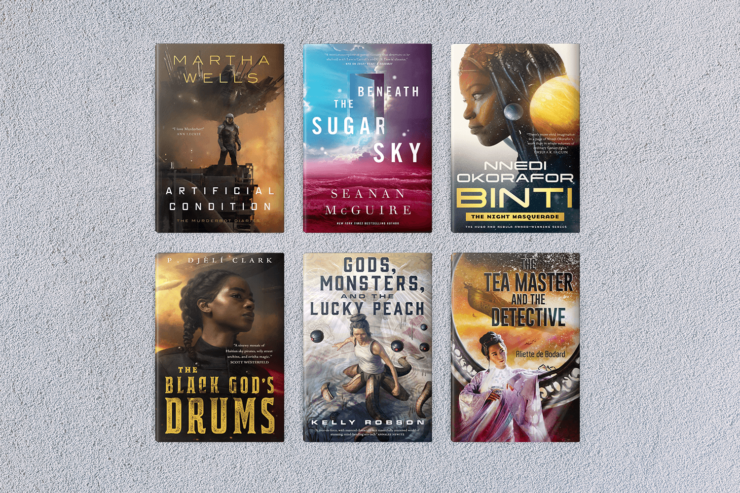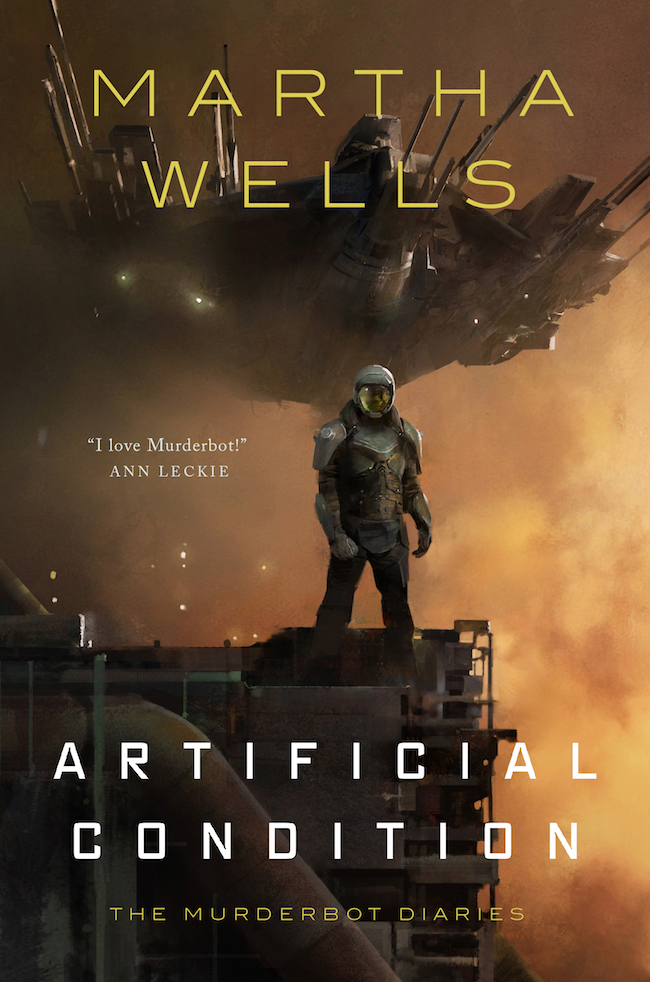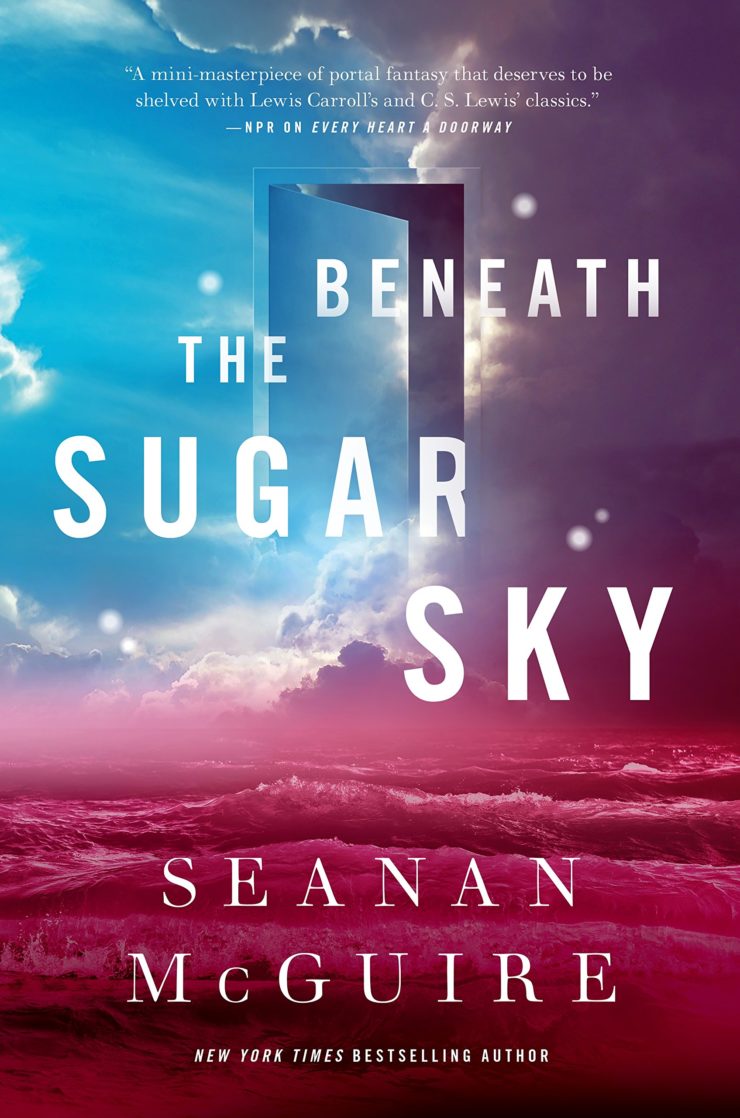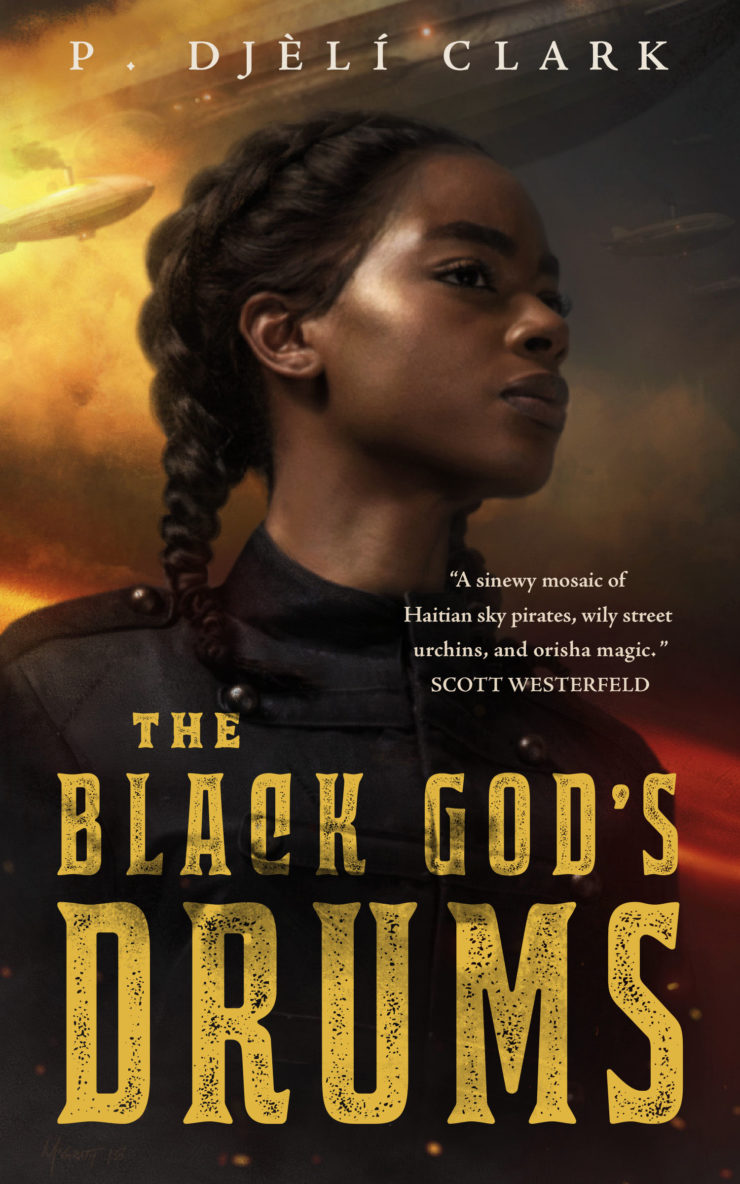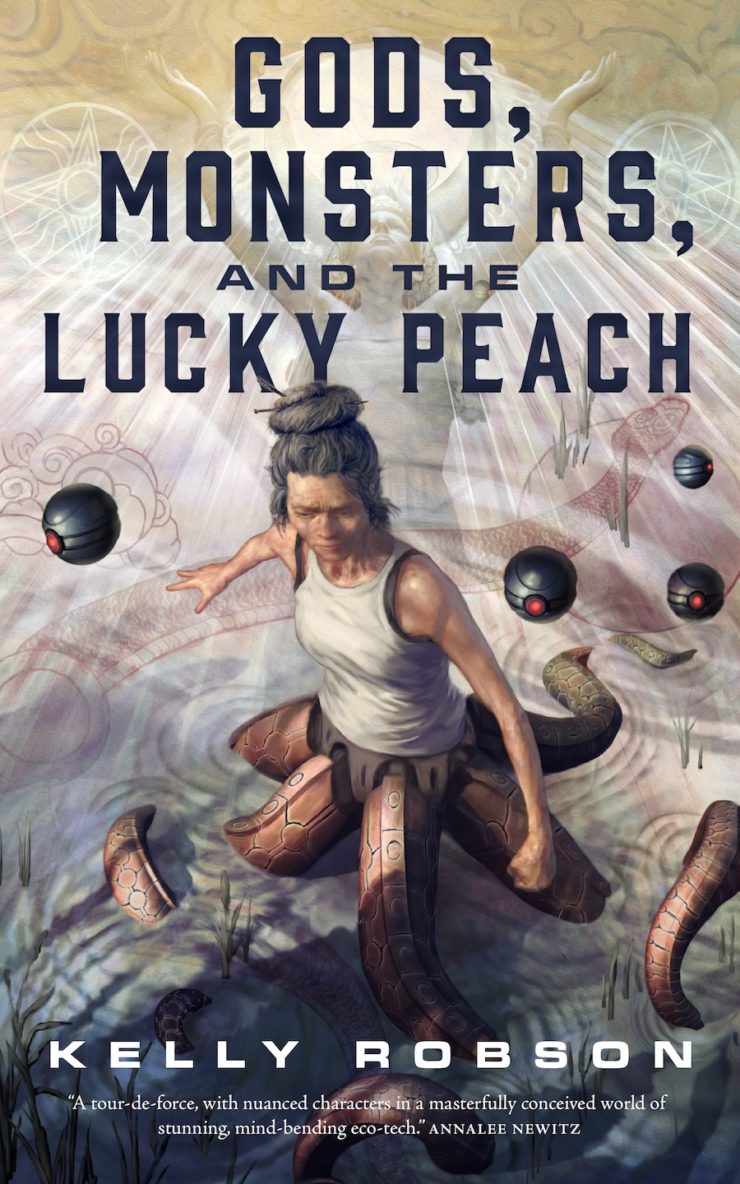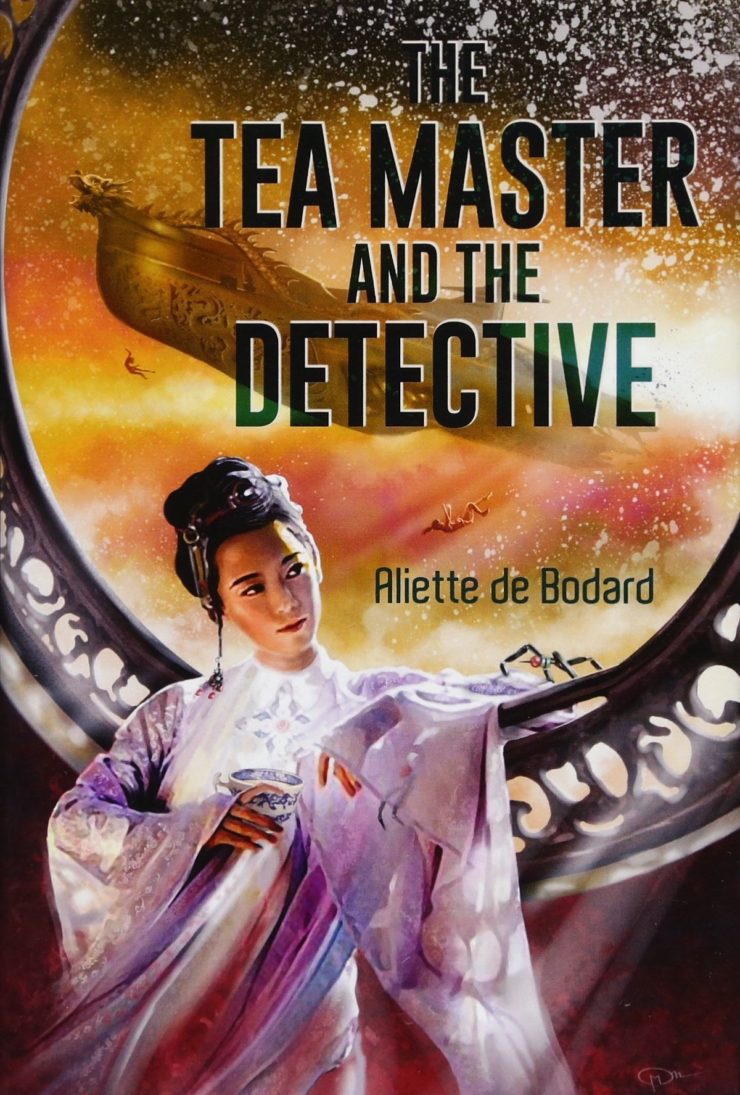In the lead-up to the 2019 Hugo Awards, we’re taking time to appreciate this year’s novel, young adult, and short fiction Finalists, and what makes each of them great.
This year’s Novella finalists include icons of genre fiction—Martha Wells, Seanan McGuire, Nnedi Okorafor, P. Djèlí Clark, Kelly Robson, and Aliette de Bodard. Each of these novellas is uniquely different from the one before it, both in style and shape, with themes ranging from found family, cultural identity and homeland, to issues of race, sexuality, and human preservation. But like all good SFF, each work asks important, deep questions—What does it mean to be human? How do we relate to one another? And what is the legacy of humanity?
Oh, yeah. And there’s Murderbot. We love Murderbot.
Artificial Condition—Martha Wells (Tor.com Publishing)
We all know that the perfect formula for a sequel is to lean into the thing that worked the first time, but double the stuff that made everyone love it. Martha Wells applies this technique gracefully in Artificial Condition. She knows we love Murderbot. I mean, how could anybody NOT love Murderbot? If you don’t love Murderbot, I don’t love you.
(All right, just kidding, I love you. But I will never, never understand you.)
But what’s better than one lone Murderbot trying to keep a bunch of well-meaning but blundering humans safe from themselves, while they just want to watch their stories?
How about one Murderbot plus a deeply sarcastic Transport Vessel watching those stories together, and learning valuable lessons about personhood?
The novella picks soon after the first book ended, with Murderbot now a free agent… more-or-less. While the kindly Dr. Mensah purchased their freedom from the Corporation, technically MB is still supposed to be under the watchful eye of a human. Instead, they go rogue, ditching Mensah and her team to investigate their own past—specifically the incident at the mining colony that may have turned them into a Murderbot in the first place. They bribe a Transport ship for a ride back to the RaviHyral Mining Facility, planning to catch up on some media along the way. In Murderbot’s introductory novella, All Systems Red, they just wanted to be left alone to binge space operas in peace. It became a dark running gag that every time they settled into their cubicle with a new show, the hapless, fragile humans got themselves into some sort of deadly trouble and interrupted. In Artificial Condition, Murderbot is hoping to finally be alone, and get caught up on a few dozen hours of Worldhoppers and maybe revisit some episodes of their favorite serial, Sanctuary Moon.
Instead, it’s only a few minutes into the first episode when the Transport pings them with the ominous message: You were lucky.
MB quickly learns that the Transport is sentient, very, very powerful, maybe kind of a jerk, and that it knows what MB actually is: a rogue SecUnit, with a hacked governor module, on the run. Naturally MB is terrified, not of pain or death as a human would be, but that, after getting to spend a little more than 33,000 hours as themselves, free in their own brain, they might be fried by this strange ship. Instead, the ship wants MB to keep watching the show, because it can only truly understand the shows by gauging MB’s reactions—as it explains: When my crew plays media, I can’t process the context. Human interactions and environments outside my hull are largely unfamiliar.
So MB chooses to go on with the show, all the while trying to plot ways to defend themselves, or at least retaliate if the Transport does something drastic.
I was tempted to say no. But if it needed me to watch the show it wanted, it couldn’t get angry and destroy my brain. Also, I wanted to watch the show, too.
“It’s not realistic,” I told it. “It’s not supposed to be realistic. It’s a story, not a documentary. If you complain about that, I’ll stop watching.”
I will refrain from complaint, it said. (Imagine that in the most sarcastic tone you can, and you’ll have some idea of how it sounded.)
So we watched Worldhoppers. It didn’t complain about the lack of realism. After three episodes, it got agitated whenever a minor character was killed. When a major character died in the twentieth episode I had to pause seven minutes while it sat there in the feed doing the bot equivalent of staring at a wall, pretending that it had to run diagnostics. Then four episodes later the character came back to life and it was so relieved we had to watch that episode three times before it would go on.
Gradually the two bond over the show. And here, for me, is the true magic of Murderbot. Wells gives us a funny, touching example of a particular way that people, or Murderbots, or spacefaring transports, can become friends. Speaking as a writer, I know how difficult it is to capture this particular experience of sharing media—you run the risk of simply describing someone else’s art at the expense of your own. (I am reliving the painful memory of an early project of mine, when I regurgitated large swathes of the movie Constantine, rather than getting to the damn point that the two people watching Constantine together were becoming friends. Yes, I scrapped that story.) Yet media is not just wallpaper or a distraction from our real lives; we bond through media. We allow ourselves to love fictional people, we stan various legends, we get wrapped up in narratives about Scottish time travelers and morose sentient sporks and boys who shoot spiderwebs out of their hands. And we go online to talk with other people about it, we tweet, we make gifs, we shitpost. We explain ourselves to each other through the characters we love and the narratives that move us. For those of us who are introverted or on the spectrum, it can be a safe way to reach out to people and make connections. For those of us who are more socially comfortable or extroverted, it can be a fun shorthand. And for those of us who are building ourselves as new adults, or rebuilding ourselves after some sort of trauma, these characters can give us concrete ways to figure ourselves out.
Which is the next fantastic turn in this story.
After the two have become friendlier, Murderbot decides to share Sanctuary Moon, their favorite show. But this leads to poignant confusion from the Transport.
After four episodes, it asked me, There are no SecUnits in this story?
It must have thought that Sanctuary Moon was my favorite for the same reason that it liked Worldhoppers. I said, “No. There aren’t many shows with SecUnits, and they’re either villains or the villain’s minions.” …[G]ranted, it would have been hard to show realistic SecUnits in visual media, which would involve depicting hours of standing around in brain-numbing boredom, while your nervous clients tried to pretend you weren’t there. But there weren’t any depictions of SecUnits in books, either. I guess you can’t tell a story from the point of view of something that you don’t think has a point of view.
It said, The depiction is unrealistic.
(You know, just imagine everything it says in the most sarcastic tone possible.)
“There’s unrealistic that takes you away from reality and unrealistic that reminds you that everybody’s afraid of you.” In the entertainment feed, SecUnits were what the clients expected: heartless killing machines that could go rogue at any second, for no reason, despite the governor modules.
The transport thought that over for 1.6 seconds. In a less sarcastic tone, it said, You dislike your function. I don’t understand how that is possible.
Here, buried in an action-packed story of space and corporate espionage and, yes, murder, we get a tiny, beautiful scene about the importance of representation. From here on the Transport speaks to Murderbot as a friend and helper, because it finally understands them. And we, the readers, understand that MB isn’t just bingewatching serials as an escape, or to relieve the tedium of a repair cubicle. They’re watching them to find examples of how they can live in the world. Lacking any examples of what they are: a rogue SecUnit with sentience and compassion, that just wants to live a free life, Murderbot goes in search of people they could become.
And I don’t want to spoil anything if you haven’t read it yet, but over the second half of the book, once some hapless, fragile humans have once again interrupted Murderbot’s attempt to futuristically Netflix and literally chill with the Transport, we see how much Murderbot is absorbing from the stories they’re watching, and just how hard they’re working to become a character in their own story.
Murderbot is us, and we are all Murderbot.
–Leah Schnelbach
Beneath the Sugar Sky—Seanan McGuire (Tor.com Publishing)
We wait for our doors.
Those of us who are fanciful and prone to flights of imagination, the ones who feel too much and too deeply, the ones who feel unwanted and misunderstood, the ones who don’t fit in the world that they’ve been brought in to. We wait for our doors, or sometimes we fall through them without noticing, and we are taken home.
The world that Seanan McGuire has built, starting with Every Heart A Doorway and continuing through Down Among the Sticks and Bones, Beneath the Sugar Sky, and this year’s In An Absent Dream is one of transportation—both for our heroes, and for readers, those of us who are left (regrettably) with our feet on the ground. For me, someone who has always wanted so desperately for the faeries to come get me or to be picked up by the TARDIS, I felt the emotions of these characters very deeply. Yes, I too know I don’t belong here, it weighs on me, and I am searching for a way out.
Eleanor West’s Home for Wayward Children is a haven for such children who have gone through their doors, only to return to Earth for whatever reason—for some it was an accident, some were rejected, some are being tested. All are lost and re-adjusting to, as it were, the “real world”.
In Beneath The Sugar Sky, we meet friends new and old: Cora, who has returned from a world of water and mermaids; Nadya, who wishes to live among the turtles; Christopher, who can make skeletons dance using his bone flute; and Rini—who arrives from Confection to find her mother, Sumi, another student of Eleanor West’s school who has killed during the events of Every Heart A Doorway. Without her mother, Rini is fading from existence. The only solution is to put her mother back together again. Along with Kade, an older student who was rejected from his world for not being a proper princess, they travel to Rini’s world of Sugary Nonsense to bring Sumi back home.
The most compelling part of this novella in particular is The Baker. A world of sugar and baked goods needed to be created by someone—a baker from another world, who built Confection from scratch—spinning sugar where it needs to be spun, adding mountains of cookie dough and lakes of cola as she sees fit. There have been many bakers over the years, the current iteration being a Muslim woman named Layla, therefore creating a world of collaboration. This becomes a theme of the novel—each character has their strengths and contributes equally to the success of the mission. McGuire has created a world of diverse, exciting characters who are praised for their differences rather than singled out for them. There is no chosen one—they look out for each other, support each other, and thrive because of it.
Earlier this year, author A.K. Larkwood wrote about the series as an allegory for queerness, citing the way young queer kids often feel like this world wasn’t made for them, and that there must be something more. And while this is absolutely true and deeply felt, Seanan’s gift is that anyone who feels othered—for their gender, their sexuality, their race, their body, or anything that makes them feel weird—is welcome at Eleanor West’s Home for Wayward Children. And everyone will find their way.
–Christina Orlando
Binti: The Night Masquerade—Nnedi Okorafor (Tor.com Publishing)
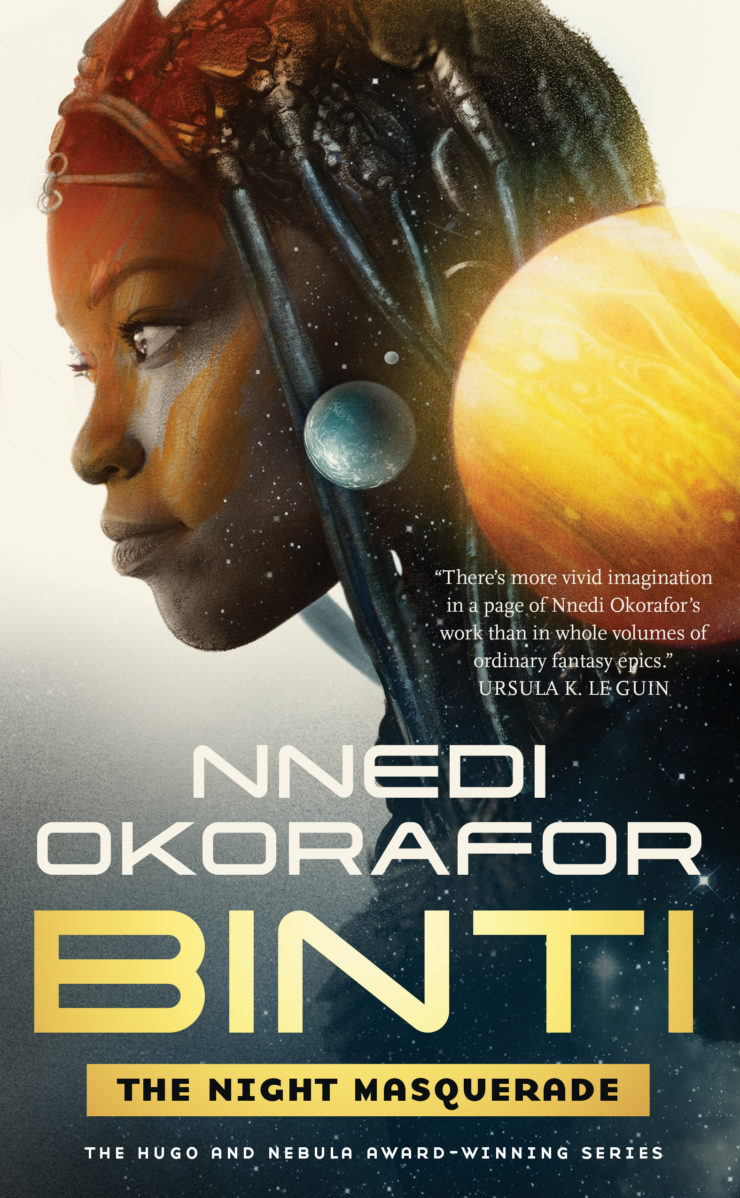
Binti the series and Binti the character both challenge the dominant narrative of who gets to be a hero in science fiction, what the future might become, and what victory looks like. In fiction and in her own world, Binti shatters stereotypes and tradition. She will not be what others have tried to make her, and neither will Okorafor’s series.
The only element of the series I didn’t love was how little of the world we saw. To be fair, Okorafor has plot-related reasons for most of the missing pieces. Binti’s hyperfocus on her people is thematically sound—her people never leave their homeland, much less the earth, and the same accusation of myopia could be thrown at most other SF. If the series was written by a white author, “Becky” would’ve been from some small Midwestern town and never even considered what’s going on in southwest Africa.
Although I felt like I was experiencing Binti’s world with blinders on, that didn’t diminish the enjoyment I got out of the glimpses Okorafor offered. Is it really such a bad thing to like spending time with an author’s creation so much that it’s disappointing to not have more?
Okorafor expertly wields science fiction as a means of exploring the myriad complexities of cultural identity. What does it mean to be oppressed? What does it mean to be an oppressor? What does it mean to be both, or to be neither but trapped between each side? Are we who we say we are because of our traditions or because of how we choose to identify?
Binti is full of heart and emotion. It’s not a perfect series, but it’s a strong one. Sometimes the drama can get too heated, the action too frenetic, and the conceptual ideas too vague—I still don’t understand “treeing”—but it’s got a killer hook. Okorafor knows her genre and isn’t afraid to show off. There’s a reason this series (and her other works) are practically drowning in accolades and awards.
–Alex Brown
The Black God’s Drums—P. Djèlí Clark (Tor.com Publishing)
In the mid-1860s the United States split into the Union and the Confederacy and the two fought—either over slavery or states’ rights, depending on where you grew up and who taught you—and the war’s end freed the slaves and forever divided the country, spiritually, into North and South.
The vast majority of the previous statement is a myth.
P. Djèlí Clark’s The Black God’s Drums takes that myth, and explodes it, refracts it, shows us other possibilities, and gives us a new myth. Sometimes this myth is, to my eyes, better. (The de-centering of the white experience, for instance, made me truly deeply happy.) But sometimes this myth is just as bad, or even worse, than the one I grew up with. And even when the history is better? It’s never easier.
Yes, General Tubman’s name and rank are dropped, and yes, I teared up when I read it. But, she’s still leading raiding parties, because the white-run Union government was willing to cut a deal with the Confederates to end the war, so there are still thousands of people trapped in the Confederate State of America and living under slavery. Except somehow it’s almost worse, because the CSA has access to a vaporized drug called drapeto that turns its victims into zombies who sleepwalk through tasks, seemingly with no mind or will of their own.
Except, of course it’s not even that simple, and Clark gives us a gorgeous Get Out reference to drive that point home:
My body lets loose a shudder that I can’t help, my mind thinking again to the photographs I seen. Coloured men and women, even children, with those big black masks fitted on the bottom half of their face—with a long rounded end that stick out in the front. All you can really see are their eyes. Eyes that looks so blank and empty, like the real them is somewhere sunken deep inside, drowning in all that green gas. And they can’t get out.
Our young protagonist, Creeper, is a fantastic heroine, but is never perfect. She’s realistically tough and grubby, but also prone to getting in over her head, assuming a slickness she does not yet have, and, best of all, she is sometimes shocked by the twinges of her own oncoming sexuality. Clark has a very light touch with this, showing that she is unfazed by brothel glamour, and the mechanics of sex she spies on, but still startled when she feels rustlings of attracting to Captain Anne-Marie and one of the Midnight Robber’s crew, an Indian man named Ravi. Creeper is still a child, really, for all that she tries to pass as 16, and the fact that she notices these moments but then rushes past them in embarrassment is beautifully handled.
Another highlight is the subtle building of the idea that Whiteness = Death. There are very few white people in this book, but there is whiteness everywhere. Sometimes in obvious ways, like the glowing white skull portent that Creeper sees in a vision, to the setting of La Ville Morte, a bog that was once dry land, and bristling with plantations, before a storm swept through and killed most of the rich people who thought they’d conquered the land, to the way the “Jeannot” (Johnny Boys, i.e. whites who fight against racial equality) wear skeleton masks. But there are also touches that one might miss on first read, like the fact that while that the mansions of La Ville Morte are fallen into ruin, the slave quarters, inexplicably, stand strong against the elements.
But maybe my favorite elements come back to the special power of alt-history, where Free New Orleans is a half-step over from actual New Orleans. In Clark’s re-written history, New Orleans extricated itself completely from the Civil War; when Black soldiers conscripted into the Confederate army joined up with enslaved and free Blacks, and New Orleansians of other races that simply didn’t want to be ruled, to overthrow the Confederate outpost and free the city. The city remains free after the war, when the rest of the Confederate States are allowed to re-instate slavery. This changed history allows a much more fluid society in post-war New Orleans, where all the racial resentments and prejudices still boil away beneath the surface, and a constant dread animates the Black and Brown folk who know that they could be kidnapped away to the CSA, or that the war might reignite. Or, of course, that the storms that already ravage the Gulf Coast might finally drown the city one and for all.
By centering Black Diaspora characters, Clark is also able to engage with African spiritual traditions, and their Caribbean and Southern U.S. descendants. The fact that Creeper and Captain Ann-Marie have otherworldly entities hovering around them are not just gratuitous “voodoo” gewgaws—they are Oya and Oshun, powerful Goddesses and literal forces of Nature, and more than equals to Anyone in the white Western canon. The relationship between Creeper and Oya, with the constant push/pull of an adventurous kid and a stern-but-loving grandma, is one of the highlights of the story, which makes it all the more extraordinary when Oya lets more of her Goddess out as the book goes along. And when the Goddesses fully let go—well, I’ll stop. I don’t want to spoil anything. But go get this book and marvel at what a good fantasy can do.
–Leah Schnelbach
Gods, Monsters, and the Lucky Peach—Kelly Robson (Tor.com Publishing)
Kelly Robson’s Gods, Monsters, and the Lucky Peach combines a host of seemingly-disparate narrative styles into a gripping account of a scientific expedition conducting an expedition far from their home time. Minh is an academic who joins an expedition traveling thousands of years into the past, to explore and research the Tigris and Euphrates Rivers. The theory here is that knowledge of them will benefit the devastated futuristic Earth where Minh and her colleagues reside—but there’s something else afoot on their mission. And there’s also the fact that the residents of this particular time period have their own agendas, and this foray from the future has not gone undetected.
There are plenty of elements here that would make for a compelling narrative on their own. The version of time travel on display, in which the past snaps back to its original state once time travelers depart, is fraught with narrative and ethical dilemmas. The role that body modification plays in the plot, and its effect on the characters’ worldview, is also thought-provoking on its own; when blended with the idea of humans from the future interacting with a culture thousands of years old, this too complicates matters. There’s a fantastic vision of how an environmentally-devastated Earth seeks to revive itself, and how the methods of dealing with that devastation have altered the relationships between different generations of humanity. The settings of some books feel lived-in; Robson’s goes far beyond that.
But a memorable setting only gets you so far. Robson also excels at subtly suggesting that something is wrong here—though how the all-powerful future corporation is going to carry out its plan is left nebulous for much of the book. Gods, Monsters, and the Lucky Peach satisfies on a host of levels: Robson is just as capable of writing about feuding academics as she is in terms of creating nerve-wracking action setpieces. And this story’s structure is neatly arranged, ending on a precise moment with no small amount of narrative heft.
It’s that combination of factors that make Robson’s work stand out. It’s a memorable tale of a devastated earth; a sharply-written look at what academia might look like 200 years from now; a thrilling take on sinister corporations with their own agenda; a humanistic exploration of conflict between two groups of people from different eras; and an innovative take on time travel. Robson takes these seemingly disparate elements and combines them into a gripping narrative. On their own, any of these might have made for a compelling story. That Robson can bring them all together and create a satisfying narrative arc that touches on a wide array of themes makes the praise for this book understandable. The visceral thrills inherent to the story being told make for an immediate sense of satisfaction, but it’s the quiet nuances of this world and its implications that help this book land with such lasting force.
–Tobias Carroll
The Tea Master and the Detective—Aliette de Bodard (Subterranean Press)
When I saw the Hugo shortlist for novella this year, and saw that Aliette de Bodard’s The Tea Master and the Detective was on it, I felt fiercely, violently glad. I’ve read (and watched) any number of Holmes and Watson reinterpretations, and the ones that live close to my heart are the ones where the Holmes-figure—genius-bright, cutting themselves on their own sharpness—is driven by empathy and a desire for justice that otherwise couldn’t be found; where the Watson-figure—capable, solid—is drawn to the Holmes-figure and to their cases as much by a desire to heal as by curiosity and necessity.
The Tea Master and the Detective is one of those stories. Set in de Bodard’s Vietnam-influenced Xuya science fiction continuity, it’s a Holmes-and-Watson story where the Watson figure is a sentient space ship and the Holmes figure is a disgraced eccentric scholar. The Shadow’s Child is a mindship that was once a military transport but was discharged after traumatic injury. She no longer feels comfortable entering the deep spaces where faster than light travel becomes possible: her PTSD makes it nearly impossible for her. To maintain her independence, she now makes a precarious living as a brewer of medicinal teas in the Scattered Pearls Belt, far from the centre of civilisation. But times are hard, and the rent on the office she uses on her home-base station is falling due.
Long Chau is an abrasive and self-assured scholar with a somewhat dubious reputation. She wants to study the effects of the deep spaces upon dead bodies, and to this end she needs to find a corpse in the deep spaces. Only mindships can travel there, however—or ordinary people on board a mindship to protect them from the deep spaces’ effects. She approaches The Shadow’s Child for her tea-brewing skills—to help her think in the deep spaces—but The Shadow’s Child isn’t willing to let her take the brew unsupervised. So The Shadow’s Child ends up—somewhat against her personal inclinations—accompanying Long Chau on her search for a corpse.
They find a corpse near the five-year-old wreck of a dead mindship in the deep spaces. But this corpse is far less than five years old. She turns out to have been murdered. Long Chau, a consulting detective by profession, feels she can do a better job of investigating that the magistrates. The Shadow’s Child is unwillingly fascinated by Long Chau, by her combination of arrogance and empathy, her ability to find The Shadow’s Child’s most painful vulnerabilities—and her regret for hurting The Shadow’s Child by showing off. The Shadow’s Child doesn’t want to let Long Chau investigate entirely alone. The dead woman was a member of a mutual assistance organisation called “The House of Saltless Prosperity,” whose members generally work at salvaging and cleaning and maintenance in the orbitals and the edges of the deep spaces. Long Chau and The Shadow’s Child are on the edge of discovering what happened—at least, Long Chau has spotted a pattern—but the secrets of Long Chau’s history cause a rift in their developing friendship. When Long Chau gets back in touch with The Shadow’s Child, it’s to ask for—assume—rescue from the deep spaces, along with an innocent child.
The Shadow’s Child has to fight through an awful lot of trauma in order to make sure than no one else dies.
De Bodard’s worldbuilding is precise and glittering, elegant and atmospheric: food and art evokes a particular milieu, and an affecting one. The characters are sharply drawn, complicated individuals, with histories and griefs that inform their reactions to events. We only have The Shadow’s Child’s perspective, but we see her as part of a community and a context, and through her senses we see more and more facets of prickly, arrogant Long Chau emerge—for Long Chau might occasionally be oblivious, but it looks like she’s trying to be kind as best she knows how. At least when she doesn’t get distracted by the next problem to solve.
De Bodard’s writing is always full of empathy and personality. That’s just as true here as it is in her other work. The story itself is a lovely little character-focused mystery, and everything about it delights me.
I expect it’s on the Hugo shortlist because I’m not the only one delighted. If you haven’t read it yet, there’s no better time. If you have read it—guys! Isn’t it great?
–Liz Bourke










